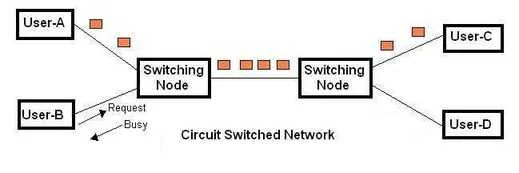Circuit switching vs packet switching - difference between circuit switching and packet switching
Following are the types of switching used for various applications.
• Circuit switching (CS): It is used for voice communication which requires dedicated connection between calling and called party to take care of
latency requirements of real time voice calls.
• Packet switching (PS): It is used for data communication which does not require dedicated connection. It is useful for less time sensitive
internet data or emails.
• Message switching (MS): It is used for message communication such as SMS, MMS etc. Refer SMS basics and types >> for more information
on how message travels from sender to the receiver.
• Before we understand the difference between circuit switching and packet switching types, let us understand the basics of circuit switching vs packet switching.
What is Circuit Switching (CS)?
In circuit switching network dedicated channel has to be established before the call is made between users. The channel is reserved between the users till the connection is active. For half duplex communication, one channel is allocated and for full duplex communication, two channels are allocated. It is mainly used for voice communication requiring real time services without any much delay.

Figure-1 : Circuit Switching
As shown in the figure-1, if user-A wants to use the network; it need to first ask for the request to obtain the one and then user-A can communicate with user-C. During the connection phase if user-B tries to call/communicate with user-D or any other user it will get busy signal from the network.
Examples of circuit switching:
• Traditional telephone network
• PSTN
What is Packet Switching (PS)?
In packet switching network unlike circuit switching network, it is not required to establish the connection initially. The connection/channel is available to use by many users. But when capacity or number of users increases then it will lead to congestion in the network. Packet switched networks are mainly used for data and voice applications requiring non-real time scenarios.

Figure-2 : Packet Switching
As shown in the figure-2, if user-A wants to send data/information to user-C and if user-B wants to send data to user-D, it is simultaneously possible. Here information is padded with header which contains addresses of source and destination. This header is sniffed by intermediate switching nodes to determine their route and destination.
In packet switching, station breaks long message into packets. Packets are sent one at a time to the network. Packets are handled in two ways, viz. datagram and virtual circuit.
In datagram, each packet is treated independently.
Packets can take up any practical route. Packets may arrive out of order and may go missing.
In virtual circuit, preplanned route is established before any packets are transmitted.
The handshake is established using call request and call accept messages.
Here each packet contains virtual circuit identifier(VCI) instead of the destination address.
In this type, routing decisions for each packet are not needed.
Examples of packet switching:
• Internet
• VoIP
Circuit switching vs Packet switching | Difference between circuit switching and packet switching networks
As shown above in Packet switched networks quality of service (QoS) is not guaranteed while in circuit switched networks quality is guaranteed.
Packet switching is used for time insensitive applications such as internet/email/SMS/MMS/VOIP etc.
In circuit switching, even if user is not talking the channel cannot be used by any other users, this will waste the resource capacity at those intervals.
The example of circuit switched network is PSTN and example of packet switched network is GPRS/EDGE.
Tabular difference between circuit switching and packet switching
Following table summarizes difference between circuit switching and packet switching in order to compare both circuit switching vs packet switching. The table also mentions difference between packet switching of datagram and virtual circuit types.
| Circuit Switching | Packet Switching(Datagram type) | Packet Switching(Virtual Circuit type) |
|---|---|---|
| Dedicated path | No Dedicated path | No Dedicated path |
| Dedicated path | No Dedicated path | No Dedicated path |
| Path is established for entire conversation | Route is established for each packet | Route is established for entire conversation |
| Call setup delay | packet transmission delay | call setup delay as well as packet transmission delay |
| Overload may block call setup | Overload increases packet delay | Overload may block call setup and increases packet delay |
| Fixed bandwidth | Dynamic bandwidth | Dynamic bandwidth |
| No overhead bits after call setup | overhead bits in each packet | overhead bits in each packet |
Conclusion:
Let us summarize the major difference between circuit switching and packet switching to compare
circuit switching vs packet switching.
➨Circuit switching is used for voice where as packet switching is used for data.
➨Circuit switching creates dedicated path where as packet switching does not.
As a result, circuit switching is sequenced communication where as packet switching is
unordered transmission.
➨Circuit switching is not cost efficient unlike packet switching.
➨Circuit switching incurs less delay where as packet switching incurs higher delay.
➨Circuit switching is highly reliable where as packet switching is less reliable.
➨Refer difference between Circuit switched call vs packet switched call >>.
Difference between packet switching and message switching | advantages and disadvantages
Refer packet switching vs message switching which mentions difference between packet switching and message switching types. Also refer advantages and disadvantages of circuit switching >>, packet switching >> and message switching >> for more information.
What is Difference between
difference between FDM and OFDM
Difference between SC-FDMA and OFDM
Difference between SISO and MIMO
Difference between TDD and FDD
Difference between 802.11 standards viz.11-a,11-b,11-g and 11-n
Networking related Links
• Basics of OSI and TCP-IP Layers
• Circuit Switched Call vs Packet Switched Call
• LAN vs WAN vs MAN
• What is Hub
• What is Switch
• What is Bridge
• What is Router
• What is Gateway
• TCP-IP Packet format
• ARP Protocol format
